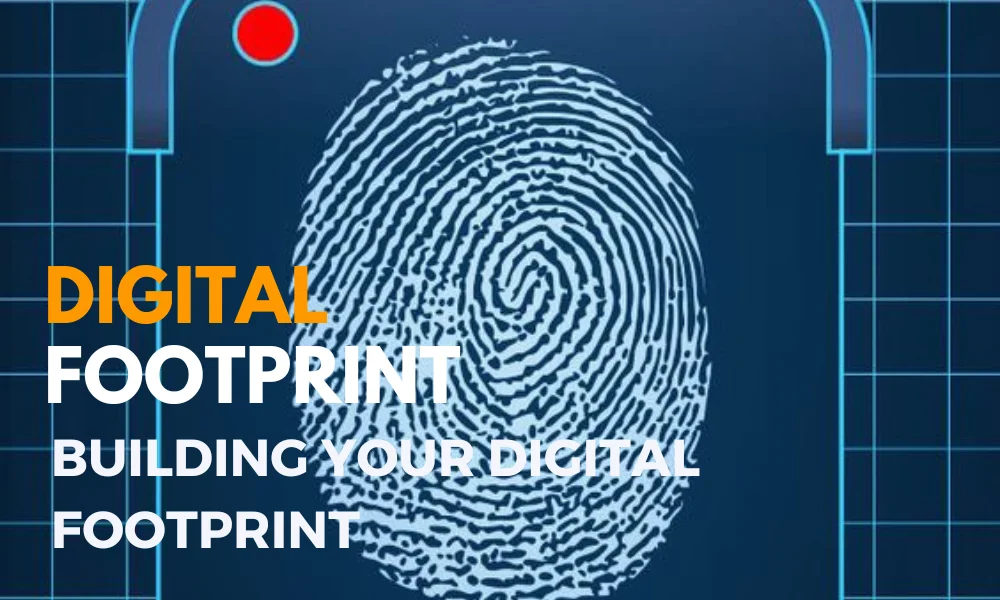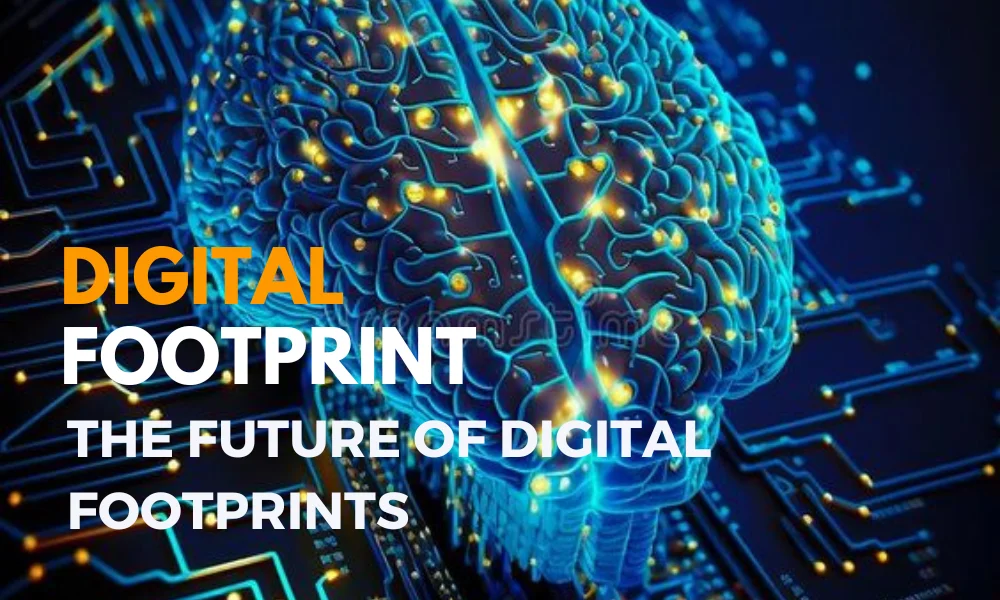Digital Footprint
The Digital Footprint: What You Need to Know about It
Our lives are becoming more and more entwined with the digital world in the internet age. Every online action we do creates a digital trail that together is referred to as our “digital footprint.” The idea of a digital footprint, its importance, how it impacts us, and strategies for managing and protecting it are all covered in this article.

Introduction
Our lives have been completely entwined with the online world in this digital age. Our digital footprint is the result of each click, post, and interaction.
There has never been a more pressing need to comprehend and manage this footprint.
The digital world has shaped our daily lives in the twenty-first century and has a significant impact on how we communicate, work, and engage with others.
We unknowingly leave a trail of breadcrumbs, or our digital footprint, as we move through this digital world. This overview prepares us for our investigation of the idea of a digital footprint, its different aspects, and the reasons it warrants our attention.
Although the phrase “digital footprint” may sound like technical jargon, it actually refers to our online presence. It includes every action we take in the digital sphere, such as web browsing, social media interaction, online purchases, and content creation.
Our digital footprints capture our activities much like footprints in the sand.

Understanding the Digital Footprint
2.1. What is a Digital Footprint?
The digital trail you leave behind while you use the internet is known as your digital footprint. It consists of the websites you go to, the searches you do, the social media posts you make, and more.
In essence, it serves as a log of your internet actions.
2.2. Types of Digital Footprints
Digital footprints typically fall into one of two categories:
- Active Footprint: This includes the information you knowingly disseminate through posts and comments on social media.
- Passive Footprint: This consists of information gathered without your consent, such as information from cookies that monitor your internet activity.
Why Does It Matter?
3.1. Impact on Privacy
Your privacy may be significantly impacted by your digital presence. Your online behaviors’ can be tracked, which can then be used for a variety of things, such targeted advertising and even identity theft.
3.2. Implications for Personal and Professional Life
Employers and organizations are looking more closely at digital traces during background investigations and hiring. Your reputation both personally and professionally may be impacted by your online presence.
Your digital trail can impact both your personal and professional lives, which goes beyond privacy issues. Employers and institutions are increasingly using digital footprints to evaluate applicants.
Your internet profile can have an impact on your social life, college admissions, and even career chances.
With this knowledge of the significance of the digital footprint, we set out on a journey to investigate its creation, the effects it has on our lives, and the actions we can take to control and safeguard it.
Additionally, we will discuss its place in the workforce, the value of educating the next generation, and the fascinating yet difficult future it brings.
Join us as we explore the complexities of the digital footprint, uncover its mysteries, and equip ourselves with the knowledge we need to make wise decisions.

Building Your Digital Footprint
4.1. Social Media Presence
Your digital footprint can be improved by developing a strong social media presence. Share pertinent information, interact with others, and have a polished appearance.
4.2. Online Forums and Communities
You can create authority in your profession by participating in online forums and communities. Be conscious of your contributions, though, and treat others with respect.
4.3. Blogging and Content Creation
By blogging and producing material, you may demonstrate your knowledge and improve your digital footprint. Share knowledge and wisdom that is useful.
Managing and Protecting Your Digital Footprint
5.1. Privacy Settings and Data Control
To limit who can see your post on social media, check and modify the privacy settings on each account. Be careful when sharing information.
5.2. Regular Digital Spring Cleaning
Review and maintain your web presence on a regular basis. Delete any out-of-date or pointless material that no longer accurately represents you.
5.3. Cybersecurity Measures
To safeguard your data from online dangers and create a more secure digital footprint, adopt good cybersecurity practices.
Digital Footprint in the Workforce
6.1. Employment and Recruitment
During the employment process, many firms take the applicant’s internet presence into account. Ensure that your internet presence matches your career goals.
6.2. Professional Branding
Developing a strong professional internet identity can lead to new employment prospects. To improve your reputation, post about your accomplishments and area of expertise online.
Educating the Younger Generation
7.1. Digital Literacy
It is essential to teach younger generations digital literacy. Give them advice on how to secure their digital traces and the repercussions of their online behaviors’.
7.2. Responsible Internet Usage
Encourage kids and teenagers to use the internet responsibly. instill the importance of privacy awareness and internet decorum.

The Future of Digital Footprints
8.1. Technological Advances
Our digital footprints will get more complicated as technology advances. Keep up with new trends and adjust as necessary.
a) Internet of Things (IoT): We will engage with the digital environment more naturally as IoT devices proliferate, from wearable technology to smart appliances.
Every time we use these gadgets, we leave a digital trace that weaves a network of related data.
b) Artificial Intelligence (AI): The analysis and interpretation of data by AI algorithms is improving. This implies that the data included in our digital footprints will be processed and used in ways we currently find difficult to fathom.
AI-driven insights will influence how businesses promote their goods, governments make decisions about public policy, and people live their digital lives.
c) Augmented Reality (AR) and Virtual Reality (VR):
The distinction between the physical and digital worlds is becoming more hazy thanks to AR and VR technologies. Our digital footprints will become more extensive in these immersive settings, capturing not only our actions but also our interactions and experiences there.
d) Biometrics and Personalization:
For increased security and personalization, digital footprints may include biometric information such as fingerprints or facial recognition.
This might fundamentally alter how we use digital platforms and access internet services.
8.2. Ethical Considerations
The expansion of digital footprints raises ethical questions. The importance of promoting ethical data handling and privacy will rise.
a) Privacy vs. Convenience:
Finding the ideal compromise between privacy and convenience will be difficult in the long run. Questions concerning who has access to our data and how it is used will grow more important as our digital footprints become more complex.
b) Data Ownership:
The question of who owns the data will be crucial. More control over one’s digital imprint will need to be asserted by the individual, including the ability to access, update, and remove personal data.
c) Security and Cybersecurity:
The potential for cyber dangers grows as the digital world does. The need to safeguard our digital footprints against breaches and theft will grow.
d) Algorithmic Bias:
Decisions made by AI that are based on digital footprints may carry biases from the data. A major ethical concern will be ensuring that these algorithms are impartial and fair.
e) Digital Citizenship:
It will be crucial to educate people about their online rights and obligations. Particularly the younger generation will need to be prepared with the knowledge and abilities to safely navigate the digital terrain.
The future of digital footprints is a double-edged sword, to sum up. On the one hand, it offers hope for more efficient and customized digital experiences.
On the other side, it prompts moral conundrums and worries about security and privacy. It’s crucial that individuals, corporations, and legislators work together to create a future in which our digital footprints benefit us without compromising our core rights and beliefs as we move forward.
It will need alertness, agility, and a dedication to the proper use of technology to successfully navigate this changing environment.
Conclusion
Our online identities today are inextricably linked to our digital footprints. Maintaining our privacy, reputation, and personal security requires that we comprehend, manage, and safeguard our digital traces.
Our digital footprints have become an essential component of our online identities in the digital age, having a significant influence on our lives.
The main points from this examination of the digital footprint will be summed up in this conclusion, which will also highlight its importance.
The concept of the digital footprint, which served as the starting point for our understanding of it, is that it is a record of our online activities, including everything from site searches to social media posts.
Additionally, we made a distinction between our active and passive digital footprints, emphasizing the information we consciously provide and that which is gathered without our knowledge.
We cannot exaggerate how crucial it is to manage and protect our digital traces. We talked about how the things we do online can have a big impact on our privacy, personal lives, and career chances.
It is crucial to cultivate a positive online presence since employers, in particular, are increasingly scrutinizing digital footprints during the recruitment process.
Making a strong social media presence, participating positively in online groups, and producing useful information through blogging are all components of creating a great digital footprint.
Achieving this requires striking a balance between self-expression and responsible online behaviors’.
We looked at controlling and preserving them in order to make sure that our digital footprints are assets rather than liabilities. Among these are modifying privacy settings, regularly cleaning up your digital life, and putting strong cybersecurity safeguards in place.
Digital footprints have had a huge impact on the job landscape, affecting employment and professional branding.
While individuals already employed can use their digital footprints to open doors to new opportunities, job searchers must be aware of how their online presence relates to their career goals.
In an increasingly digital world, it is crucial to teach the next generation about digital literacy and appropriate internet usage. We all have a responsibility to teach kids how to use the internet responsibly and safely.
We must think about the effects of developing technologies on our digital footprints as we look to the future. The importance of ethical considerations increases as trends change constantly.
The future of digital footprints will be greatly influenced by advocacy for responsible data handling and privacy practices.
In conclusion, your digital identity is reflected in your digital footprint, which is more than just a result of your online behaviors’.
To protect your privacy, improve your personal and professional life, and make a positive impact on the digital world, you must manage it correctly. Be aware of the traces you leave behind because, in this linked world, they define your digital legacy.
Frequently Asked Questions (FAQs)
- What is the difference between an active and passive digital footprint?
- An active digital footprint is made up of information you knowingly disclose online, whereas a passive digital footprint is made up of information gathered without your knowledge.
- Why is managing your digital footprint important for job seekers?
- Employers frequently examine a candidate’s internet presence to judge their suitability and professionalism.
- How can I protect my digital footprint from cyber threats?
- Put robust cybersecurity precautions in place, like utilizing safe passwords and updating software frequently.
- What are the long-term implications of a negative digital footprint?
- A damaging digital footprint can harm one’s reputation and limit one’s access to personal and professional prospects.
- How can I teach my children about responsible internet usage and protecting their digital footprints?
- Establish rules for their online behaviors’ after talking about internet safety and privacy.
Your digital footprint is a digital extension of yourself in a society where the physical and digital worlds are intertwined. To successfully traverse the digital environment, be aware of the imprints you leave and take charge of your online profile.
What is my access to my digital footprint?
Your Digital Footprint: How to Discover It. Go to Google, Bing, or any other search engine, type your entire name, then hit ENTER to learn what personal information is publicly available about you online.
What internet information is available about you is shown in the search results.
Which five digital footprints are examples?
What exactly is a digital footprint, and why is it important?
some examples of your digital footprint data
- Making internet purchases.
- Creating an account or registering for coupons.
- Signing up for newsletters.
- Using and downloading shopping apps.
Which 2 sorts of digital footprints are there?
Data left behind by users after they utilize the internet is known as a digital footprint.
Digital footprints come in two flavors’: passive and active.
How does social media footprint work?
KRHS GUIDANCE: Managing Your Social Media Footprint
WHAT IS THE FOOTPRINT OF YOUR SOCIAL MEDIA? In essence, it is a trail or record of everything you do or post online. Images, videos, posts, and browsing history are all included.
WHAT IS THE PURPOSE OF CONCERNING YOUR SOCIAL Media Footprint?
Information spreads quickly and is frequently misinterpreted.
Why does one leave a digital footprint?
What does “Digital Footprint” mean?
Your digital footprint is the information trail you leave behind whenever you use the internet. There are several methods to leave a digital footprint, such as posting on social media, signing up for a newsletter, writing an online review, or conducting online business.
Why lessen your online footprint?
A digital footprint is a collection of your online data, and it can have an effect on your safety, prospects for both personal and professional growth, and online reputation. Additionally, businesses gather data on your internet activity in order to later target you with relevant adverts.
Digital footprint is used by who?
Digital footprints are a useful hiring tool since they might reveal a person’s compatibility with a company’s values or their interpersonal skills.
Digital footprints, unfortunately, can also be useful to fraudsters. Some people utilize this data to assume the identities of other users and steal their money.
Is my digital footprint visible to others?
The data that is publicly accessible, such as your social media posts or details on a website’s public profile, is known as your “public digital footprint.” Private digital footprint: Information available only to a select number of people, such as group chat messages or online member-only forums.
What exactly is a student’s digital footprint?
Data you leave behind online is referred to as a digital footprint. Visited websites, emails, and data shared with internet services are all included. Some digital footprints are passive, meaning you didn’t intend to leave the information behind.
What is stored in a digital footprint?
Depending on the circumstance, there are numerous ways to store them. A “hit” in an online environment may be a footprint that is recorded in a database. The footprint may record the user’s IP address, the time it was formed, where it originated, and the location of the footprint when it was later analyzed.
What are the different kinds of footprints?
The impressions or pictures that a person’s running or walking leaves behind are called footprints. The prints formed by animals using their hooves or paws as opposed to their feet are referred to as “hoofprints” or “pawprints,” while the word “shoeprints” is reserved for prints made by shoes.
Why is a student’s digital footprint important?
Our future may be impacted by our digital footprints. How people see or feel about us is influenced by what they learn about us online.
Give your students advice on how to control what others discover and perceive about them online, as well as how to understand their digital footprint.
Does leaving a digital footprint harm the environment?
Every single search request, streamed movie, and type of cloud computing, which are all done billions of times each, are to blame for the rising global energy demand and, consequently, the rising CO2 emissions. Due to the enormous data volumes of videos, video streaming accounts for the lion’s share of the digital footprint.

